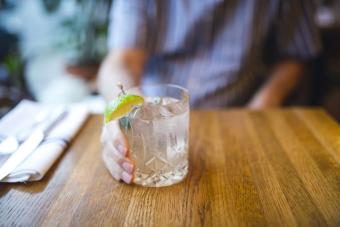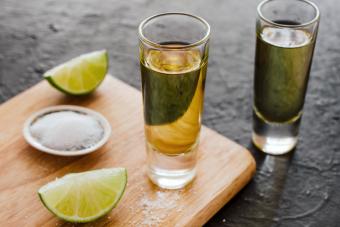
As one of the oldest and perhaps most underrated liquors in existence, gin presents an interesting challenge to first-time drinkers. This botanical booze doesn't often become someone's drink of choice until long after their experimental teen and young adult years. With so few popular college cocktails sweeping campuses with gin as their base, many people don't learn how to drink gin when they're first taste testing everything that they can get their hands on. So, if you've been straying away from trying gin because you're not quite sure where to even start, let this helpful guide break the junipery ingredient down for you.
Classic Ways to Drink Gin
You can drink most liquors on their own, and they are usually served in three separate styles: straight, on the rocks, and neat. Take a look at how these ways of drinking gin by itself differ and see which one of them is the way that you've been unknowingly ordering it for years.
Straight

To drinking gin straight up, chill it first as gin is best ice cold. Pour the gin in a mixing glass filled with ice and stir it. Then, and strain it into a rocks glass. This is perfect if you forgot to keep your gin chilled or prefer your drinks on the cooler side.
On the Rocks

People who love cold drinks should try their liquor on the rocks. To serve gin on the rocks means, fill a rocks glass with ice and pour gin over the top. The ice will dilute the gin as it melts, which makes this method not quite as strong as serving it straight.
Neat

Gin's flavors develop differently at different temperature. So one way to give yourself a different gin experience is to serve it neat. Many seasoned gin lovers enjoy it this way. To serve gin neat, pour room temperature gin into a glass and sipping it slow or down it in one go.
Mix Gin Into Cocktails
Given that gin has been used since the Medieval period as a medicinal treatment, it's only fitting that some talented mixologists would create delicious gin cocktails for you to enjoy. Check out these three staple gin drinks and see which one you think tastes the best.
Gin Martinis

An absolute classic gin drink is a gin martini. The amount of vermouth you add determines whether the drink is dry (less vermouth) or wet (more vermouth). These martinis can be rather strong given they're just a combination of dry gin and dry vermouth. If you want to cut back on some of that strength, add a splash of water to dilute the liquor. A martini should be served well chilled in a chilled martini glass.
Gin & Tonics

The gin and tonic, or G&T as it's sometimes called, is one of the oldest recorded mixed drinks in the historical record. It developed in the British colonies as a way for colonial officials to combat malaria; they would mix quinine with gin and tonic water to mask the medicine's overwhelming taste. This three-ingredient cocktail is so easy, even a first-time drink mixer can put it together.
Negroni

The Negroni is a pre-Prohibition cocktail created in Italy that combines the bitter Italian apéritif, Campari, with dry gin and sweet vermouth, and results in a bold red cocktail that has a bittersweet edge. Popular for both its taste and its impressive appearance, the Negroni is another three-ingredient cocktail that you can whip up at your home bar in seconds.
Best Flavor Pairings With Gin
Sometimes, you just don't have the energy or time to be able to make an entire cocktail, and want to slip a little bit of booze into one or two ingredients. While you probably haven't tended bar or trained to become a mixologist, it's easy enough to craft your own cocktails and beverages at home once you're familiar with the different ingredients that always pair well with gin's aromatics.
Tea

Surprisingly, tea is actually a wonderful thing to pair with gin. In particular, Earl Grey's bergamot brew interacts with the gin's botanicals to create a really pleasing flavor. For all of you tea drinkers out there, try adding some gin to your morning cup and see what you think.
Florals

Given that gin is made from steeping liquor in a mixture of juniper berries and other herbs and botanicals, it only makes sense that similar natural ingredients would pair well with it. If you're a fan of floral flavors--and don't worry, many people aren't--you can experiment with combinations like lavender and gin or rosemary and gin.
Summer and Spring Fruits

Due to gin's natural botanicals and strong aromatics, you should stick to combining it with summer and spring fruits and citrus as these fruits' flavors are most complementary to the liquor's base notes. While you may favor tropical fruits like coconuts or fall fruits like pumpkin, the most pleasing cocktails are going to come from mixtures of things like gin and strawberry or gin and lime.
Fresh Approaches to Gin
While conventional gin will always do the trick, you might want to branch out with some of the modern brewing trends that have begun transforming gin from a historic ingredient into a contemporary powerhouse.
Gin Infusions

Whether you try it at home or purchase a professionally done batch, infused gin can give you the kick in your cocktail recipe that you are looking for. Steeping ingredients in a plain bottle of gin over a few days/weeks will give you a pantry full of highly unique and personal gin flavors. For instance, you could have turmeric gin or blueberry lavender gin if you so wanted to.
Barrel Aged Gin

A more recent, underground way of creating a gin is barrel aging it. This barrel aging is the process that lends the typically dark/brown liquors their coloring through literally aging the liquids in oak barrels. However, you don't have to be worried that barrel aging gin is going to completely change the liquor's distinct flavor. Since you don't have to age it as long as other liquors, you don't get nearly as many tannins out of the oak, leaving the gin with just a hint of something different.
Take a Chance on Something New
Now that you're more familiar with how to approach drinking gin, you should be able to grab the seasoned liquor by the bottle and take the proverbial first plunge. When you find your new favorite cocktail, such as the army and navy cocktail or the classic Alexander cocktail, you'll be absolutely thrilled that you did.







